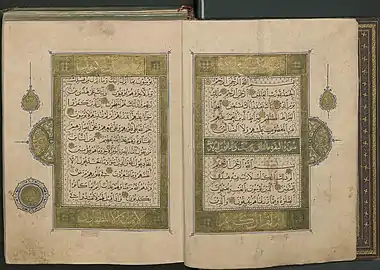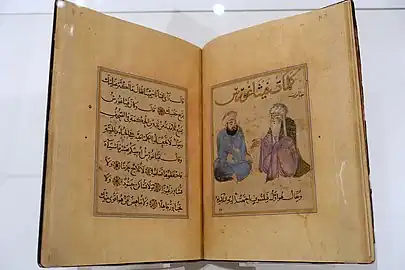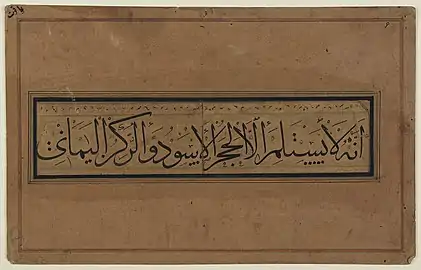Yaqut al-Musta'simi
Yaqut al-Musta'simi (Arabic: ياقوت المستعصمي) (died 1298[1]) was a well-known calligrapher[2][3] and secretary of the last Abbasid caliph.
Yaqut al-Musta'simi ياقوت المستعصمي | |
|---|---|
.jpg.webp) | |
| Born | Amaseia (modern-day Amasya, Turkey) |
| Died | 1298 |
| Known for | Islamic calligraphy |
| Patron(s) | Al-Musta'sim |
Life and work
He was probably of Greek origin in Amaseia and carried off when he was very young into slavery. Made into a eunuch, he was converted to Islam as Abu’l-Majd Jamal al-Din Yaqut, better known as Yaqut al-Musta‘simi because he served Caliph al-Musta‘sim, the last Abbasid caliph.[4]
He was a slave in the court of al-Musta'sim and went on to become a calligrapher in the Royal Court. He spent most of his life in Baghdad.[5] He studied with the female scholar and calligrapher, Shuhda Bint Al-‘Ibari, who was herself a student in the direct line of Ibn al-Bawwab.[6] During the Mongol invasion of Baghdad (1258), he took refuge in the minaret of a mosque so he could finish his calligraphy practice, while the city was being ransacked. His career, however, flourished under Mongol patronage.[7]
He refined and codified six basic calligraphic styles of the Arabic script.[8] Naskh script was said to have been revealed and taught to the scribe in a vision. He improved on Ibn Muqla's style by replacing the straight cut reed pen with an oblique cut, which resulted in a more elegant script.[9] He developed Yakuti, a handwriting named after him, described as a thuluth of "a particularly elegant and beautiful type."[1]
He taught many students, both Arab and non-Arab. His most celebrated students are Ahmad al-Suhrawardi and Yahya al-Sufi.[10]
He became a much-celebrated calligrapher across the Arab-speaking world. His school became the model followed by Persian and Ottoman calligraphers for centuries. In the second half of the 13th-century, he gained the honorific, quiblat al-kuttab [cynosure of the calligraphers].[11]
His output was prolific. Although, he is said to have copied the Qur'an more than a thousand times,[12] problems with attributing his work, may have contributed to exaggerated estimates.[13] Other sources suggest that he produced 364 copies of the Q'ran.[14] He was the last of the great medieval calligraphers.[15]
 Double page of Quran, dated to 1286–1287. Rayhani script. Turkish and Islamic Arts Museum
Double page of Quran, dated to 1286–1287. Rayhani script. Turkish and Islamic Arts Museum_by_Ya'qut_al-Musta'simi.jpg.webp) Two pages from the manuscript of "Divan shu’r al-Hadira" (The collected verses of Al-Hadira). Naskh and thuluth script. Freer Gallery of Art
Two pages from the manuscript of "Divan shu’r al-Hadira" (The collected verses of Al-Hadira). Naskh and thuluth script. Freer Gallery of Art Two pages from the manuscript of the 'Spiritual Words from Greek Philosophy with Sayings of the Philosophers Accompanied with their Portraits' (Al-Kalimat al-Ruhaniyya min al-Hikam al-Yunaniyya fi Kalimat al-Hukama’ wa Ashkalihim). Naskh script. Painting by Mahmud b. Abi'l-Mahasin Al-Qashi. Aga Khan Museum
Two pages from the manuscript of the 'Spiritual Words from Greek Philosophy with Sayings of the Philosophers Accompanied with their Portraits' (Al-Kalimat al-Ruhaniyya min al-Hikam al-Yunaniyya fi Kalimat al-Hukama’ wa Ashkalihim). Naskh script. Painting by Mahmud b. Abi'l-Mahasin Al-Qashi. Aga Khan Museum Line in thuluth. Part of the pilgrimage guide. Library of Congress
Line in thuluth. Part of the pilgrimage guide. Library of Congress_with_Arabic_aphorisms_written_by_Yaqut_al-Musta%E2%80%98simi.jpg.webp)
References
- Efendi, Cafer; Howard Crane (1987). Risāle-i miʻmāriyye: an early-seventeenth-century Ottoman treatise on architecture: facsimile with translation and notes. Brill. p. 36. ISBN 978-90-04-07846-8. Retrieved 26 July 2010.
- Dankoff, Robert (2004). An Ottoman mentality: the world of Evliya Çelebi. Brill. p. 42. ISBN 978-90-04-13715-8.
- Çelebi, Evli̇ya; Robert Dankoff (2006). Evliya Çelebi in Bitlis: the relevant section of the Seyahatname. Brill. p. 285. ISBN 978-90-04-09242-6. Retrieved 26 July 2010.
- Houtsma, M. Th (1987). E.J. Brill's First Encyclopaedia of Islam 1913–1936, Volume 1. BRILL. p. 1154. ISBN 9789004082656.
YAKUT al-MUSTA'SIMI, Djamal al-DIn Auu 'l-Madjd ... some say he was a Greek from Amasia; he was probably carried off on a razzia while still very young. He was a eunuch.
- Osborn, J.T., Letters of Light: Arabic Script in Calligraphy, Print, and Digital Design, Harvard University Press, 2017, [E-book edition], n.p.
- Robinson, G., The Cambridge Illustrated History of the Islamic World, Cambridge University Press, 1996, p. 268; Bloom, J. and Blair, S.S., Grove Encyclopedia of Islamic Art & Architecture, Vol. 1, Oxford University Press, 2009, p. 442
- Bloom, J. and Blair, S.S., Grove Encyclopedia of Islamic Art & Architecture, Vol. 1, Oxford University Press, 2009, p. 442; "Yaqut al-Musta'simi" [Biography], Islamic Arts, Islamic Arts Online (in English):
- Sözen, Metin; İlhan Akşit (1987). The evolution of Turkish art and architecture. Haşet Kitabevi.
- Bloom, J. and Blair, S.S., Grove Encyclopedia of Islamic Art & Architecture, Vol. 1, Oxford University Press, 2009, p. 442; Sajoo, A.B., A Companion to Muslim Cultures, I.B.Tauris, 2011, p. 148
- Sajoo, A.B., A Companion to Muslim Cultures, I.B.Tauris, 2011, p. 148; Bloom, J. and Blair, S.S., Grove Encyclopedia of Islamic Art & Architecture, Vol. 1, Oxford University Press, 2009, p. 442
- Türk ve İslâm Eserleri Müzesi, The Art of the Qurʼan: Treasures from the Museum of Turkish and Islamic Arts, Smithsonian Institution, 2016, p. 80
- Knappert, Jan (2005). Swahili culture, Book 2. E. Mellen Press. ISBN 978-0-7734-6109-3.
- Mansour, N., Sacred Script: Muhaqqaq in Islamic Calligraphy, I.B. Tauris, 2011, p. 88n
- Islamic Arts, Islamic Arts Online (in English):
- Robinson, G., The Cambridge Illustrated History of the Islamic World, Cambridge University Press, 1996, p. 268